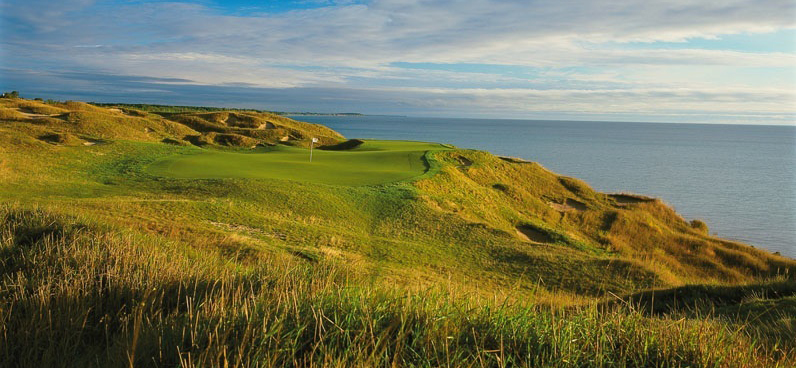10 Things to Know About Whistling Straits
August 8, 2015
Wisconsin
- History — Owner Herb Kohler set out to build Whistling Straits as a venue for a men’s major. It debuted in on July 6, 1998 and hosted its first major in 2004 (The PGA Championship won by Vijay Singh). The site where Whistling Straits sits used to be flat, barren, unspectacular farmland. In the 1950s, the U.S. Army utilized the land for an antiaircraft training area.
- Inspiring Setting — The Straits Course at Whistling Straits is routed along two miles of stunning Lake Michigan coastline with 8 holes that play along the coast. Note: The 36-hole complex also includes the Irish Course.

- Course Name — The unique and catchy name was the idea of owner Herb Kohler, Executive Chairman of the Kohler Company, who walked the site many times during construction of the course. On one particularly windy day he could hear the wind whistling through the bluffs and the waves crashing on the rocky shoreline (The Straits) on Lake Michigan. Voila, one of the world’s most recognizeable course names was born.
- Walking-Only — You don’t ride around in golf carts at The Straits. It’s a walking-only course and caddies are required prior to twilight.
- Sheep–You’ll have some spectators at Whistling Straits. During the golf season, a flock of Scottish blackface sheep roam the property providing golfers a British Isles ambiance on the American links-style layout.
- The Specs — Average size of greens: 7,500 square feet; Average tee size: 6,000 square feet; Acres of fairways: 22; Acres of rough: 15
- Pete Dye Design — The Hall of Fame designer, architect of iconic courses like Teeth of the Dog at Casa de Campo and THE PLAYERS TPC Sawgrass course, essentially created a course that could almost be airdropped into Ireland. At Whistling Straits, Dye had 13,126 truckloads of sand hauled in to create dunes, hills and fescue grass fairways. He received some design assistance from his wife Alice.
- Links-Style — Dominated by bluffs and giant sand dunes, the layout has fescue fairways, more than 500 bunkers and 14 water hazards. A links-style course, it requires a wide variety of shots. When the wind blows hard, a creative ground game is needed to score well.
- Dustin Disaster — In the 2010 PGA Championship, Dustin Johnson hit his drive wide right into a bunker on No. 18 hole on the final day of play. He and his caddie mistakenly thought it was just a worn out area of the course and Johnson grounded his club. The result was a two-stroke penalty and Johnson’s championship dreams went down the drain.
- The Other Course — Often overlooked in the Whistling Straits complex is The Irish Course, a Pete Dye design with more than 2,000 trees, a 10.5 acre lake and four streams that weave through the layout.

Meet the Author: Bill Hogan
Bill Hogan is based in Austin, TX and has over 35 years of experience in the luxury golf travel industry.
He has played golf in 57 different countries to date, is a long- time panelist for GOLF Magazine World & USA Top 100 courses, and on the ranking panel for Platinum Clubs of the World.
Share this:
